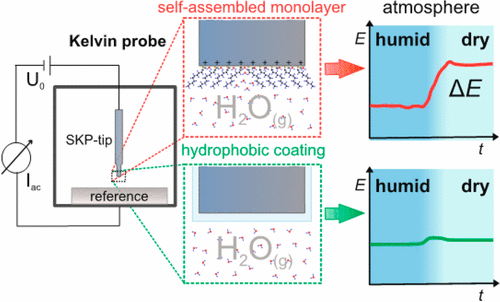Our official English website, www.x-mol.net, welcomes your
feedback! (Note: you will need to create a separate account there.)
Fabrication of Robust Reference Tips and Reference Electrodes for Kelvin Probe Applications in Changing Atmospheres
Langmuir ( IF 3.7 ) Pub Date : 2017-10-05 00:00:00 , DOI: 10.1021/acs.langmuir.7b02533 M. Uebel 1 , A. Vimalanandan 1 , A. Laaboudi 1 , S. Evers 1 , M. Stratmann 1 , D. Diesing 2 , M. Rohwerder 1
Langmuir ( IF 3.7 ) Pub Date : 2017-10-05 00:00:00 , DOI: 10.1021/acs.langmuir.7b02533 M. Uebel 1 , A. Vimalanandan 1 , A. Laaboudi 1 , S. Evers 1 , M. Stratmann 1 , D. Diesing 2 , M. Rohwerder 1
Affiliation

|
The scanning Kelvin probe (SKP) is a versatile method for the measurement of the Volta potential difference between a sample and the SKP-tip (ΔψsampleSKP-tip). Based on suitable calibration, this technique is highly suited for the application in corrosion science due to its ability to serve as a very sensitive noncontact and nondestructive method for determining the electrode potential, even at buried interfaces beneath coatings or on surfaces covered by ultrathin electrolyte layers, which are not accessible by standard reference electrodes. However, the potential of the reference (i.e., the SKP-tip) will be influenced by variations of the surrounding atmosphere, resulting in errors of the electrode potential referred to the sample. The objective of this work is to provide a stable SKP-tip which can be used in different or changing atmosphere, e.g., within a wide range of relative humidity (approximately 0–99%-rh) or varying O2 partial pressure, without showing a change of its potential (note that the work functions measured in non-UHV atmospheres are electrochemical in nature [Hausbrand et al. J. Electrochem. Soc. 2008, 155 (7), C369–C379], and hence in the following we will refer to the potential of the SKP-tip instead of its work function). In that regard, the SKP-tip is in a first approach modified with self-assembled monolayers (SAMs) in order to create a hydrophobic barrier between the metallic surface and the surrounding atmosphere. The changes in potential upon varying relative humidity (ΔErh) of different bare metallic substrates are quantified, and it is shown that these potential differences cannot be minimized by SAMs. On the contrary, the ΔErh increases for every examined material system modified with SAMs. The major explanation for this observation is the dipole layer at the interface metal|SAM, causing an interfacial adsorption of water molecules even in a preferred orientation of their dipole moments, which leads to a changed work function and consequently to the correlated electrode potential. However, thin paraffin coatings were found to lead to a strongly reduced ΔErh, finally validated with novel robust Ag/Ag+ reference electrodes. It is also shown that nickel as SKP-tip material is seemingly more stable in varying atmospheric conditions compared to widely used Ni/Cr, stainless steel, or gold as SKP-tip material.
中文翻译:

用于变化环境中的开尔文探针应用的稳健参考尖端和参考电极的制造
扫描开尔文探针(SKP)是一种用于测量样品和SKP尖端(Δψ样品SKP尖端)之间的伏特电位差的通用方法)。基于适当的校准,该技术非常适用于腐蚀科学,因为它具有非常灵敏的非接触非破坏性方法来确定电极电势的能力,即使在涂层下方的掩埋界面或超薄电解质层覆盖的表面上也是如此,这是标准参比电极无法接近的。但是,参比电极的电势(即SKP尖端)将受到周围大气变化的影响,从而导致参考样品的电极电势产生误差。这项工作的目的是提供一种稳定的SKP烙铁头,该烙铁头可在不同或变化的气氛中使用,例如,在相对湿度(大约0-99%-rh的宽范围)或变化的O 2范围内使用分压,而不会显示出其潜在的变化(注意,在非UHV环境测得的功函数在本质上电化学[Hausbrand等电化学会志J.。 2008,155(7),C369-C379]和因此,在下文中,我们将参考SKP技巧的潜力,而不是其工作功能。在这方面,SKP-tip是采用自组装单层(SAM)进行修改的第一种方法,目的是在金属表面和周围大气之间形成疏水屏障。量化了在不同裸金属基板的相对湿度(ΔE rh)变化时电势的变化,并且表明这些电势差无法通过SAM最小化。相反,Δ对于使用SAM修改的每个检查的物料系统,E rh都会增加。该观察的主要解释是界面金属上的偶极子层,即使在偶极矩的优选取向下也会引起水分子的界面吸附,这导致功函数改变,从而导致相关的电极电位。但是,发现薄的石蜡涂层会导致ΔE rh大大降低,最终用新型坚固的Ag / Ag +参比电极进行了验证。还表明,与广泛使用的Ni / Cr,不锈钢或金作为SKP尖端材料相比,镍作为SKP尖端材料似乎在变化的大气条件下更稳定。
更新日期:2017-10-05
中文翻译:

用于变化环境中的开尔文探针应用的稳健参考尖端和参考电极的制造
扫描开尔文探针(SKP)是一种用于测量样品和SKP尖端(Δψ样品SKP尖端)之间的伏特电位差的通用方法)。基于适当的校准,该技术非常适用于腐蚀科学,因为它具有非常灵敏的非接触非破坏性方法来确定电极电势的能力,即使在涂层下方的掩埋界面或超薄电解质层覆盖的表面上也是如此,这是标准参比电极无法接近的。但是,参比电极的电势(即SKP尖端)将受到周围大气变化的影响,从而导致参考样品的电极电势产生误差。这项工作的目的是提供一种稳定的SKP烙铁头,该烙铁头可在不同或变化的气氛中使用,例如,在相对湿度(大约0-99%-rh的宽范围)或变化的O 2范围内使用分压,而不会显示出其潜在的变化(注意,在非UHV环境测得的功函数在本质上电化学[Hausbrand等电化学会志J.。 2008,155(7),C369-C379]和因此,在下文中,我们将参考SKP技巧的潜力,而不是其工作功能。在这方面,SKP-tip是采用自组装单层(SAM)进行修改的第一种方法,目的是在金属表面和周围大气之间形成疏水屏障。量化了在不同裸金属基板的相对湿度(ΔE rh)变化时电势的变化,并且表明这些电势差无法通过SAM最小化。相反,Δ对于使用SAM修改的每个检查的物料系统,E rh都会增加。该观察的主要解释是界面金属上的偶极子层,即使在偶极矩的优选取向下也会引起水分子的界面吸附,这导致功函数改变,从而导致相关的电极电位。但是,发现薄的石蜡涂层会导致ΔE rh大大降低,最终用新型坚固的Ag / Ag +参比电极进行了验证。还表明,与广泛使用的Ni / Cr,不锈钢或金作为SKP尖端材料相比,镍作为SKP尖端材料似乎在变化的大气条件下更稳定。

































 京公网安备 11010802027423号
京公网安备 11010802027423号